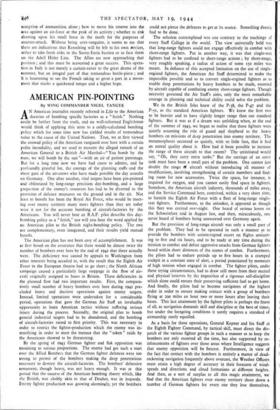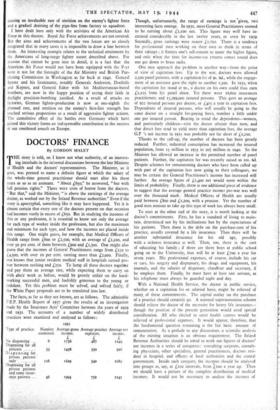AMERICAN PIN-POINTING
By WING COMMANDER NIGEL TANGYE
AN American journalist recently referred in Life to the American doctrine of bombing specific factories as a " fetish." Nothing could be farther from the truth, and no well-informed Englishman would think of applying this term to a coldly-calculated bombing policy which for some time now has yielded results of tremendous value to the cause of the United Nations. True, we at first viewed the avowed policy of the American vanguard over here with a certain polite incredulity, and we used to recount the alleged remark of an American General to a British Air Marshal—" You bomb by the stars, we will bomb by the sun "—with an air of patient patronage. But for a long time now we have had cause to admire, and be profoundly grateful for, the courage of the planning staffs and the sheer guts of the air-crews who have made possible the day assaults on Germany. One after another, vital targets have been pin-pointed and obliterated by long-range precision day-bombing, and a large proportion of the enemy's resources has had to be diverted to the provision of defence measures on the ground and in the air. Not least to benefit has been the Royal Air Force, who would be meet- ing over enemy territory many more fighters than they are today were it not for the accurate bombing of aircraft-factories by the Americans. You will never hear an R.A.F. pilot describe this day- bombing policy as a " fetish," nor will you hear the word applied by an American pilot to the British night-bombing policy. The two are complementary, even integrated, and their results yield mutual benefit.
The American plan has not been easy of accomplishment. It was at first based on the assurance that there would be almost twice the number of bombers over here by the end of 1942 that there actually were. The deficiency was caused by appeals to Washington from other interests being acceded to, with the result that the Eighth Air Force in the European theatre had to go short ; the North African campaign caused a particularly large stoppage in the flow of air- craft originally assigned to bases in Britain. These deficiencies in the planned flow had two important results. First, the compara- tively small number of heavy bombers over here during 1942 pre- cluded heavy and decisive operations against enemy targets. Instead, limited operations were undertaken for a considerable period, operations that gave the German Air Staff an invaluable opportunity to learn American tactics without suffering serious injury during the process. Secondly, the original plan to bomb general industrial targets had to be abandoned, and the bombing of aircraft-factories raised to first priority. This was necessary in order to restrict the fighter-production which the enemy was in- tensifying in order to meet the menace that the " token " raids by the Americans showed to be threatening.
By the spring of 1943 German fighter and flak opposition was mounting to serious proportions. The enemy bad got such a start over the Allied Bombers that the German fighter defences were too strong to permit of the bombers making the deep penetrations necessary to destroy the aircraft-factories. The bombers' defensive armament, though heavy, was not heavy enough. It was at this period that the success of the American bombing theory which, like the British, was doely akin to that of Douhet, was in jeopardy. Enemy fighter production was growing alarmingly, yet the bombers could not pierce she defences to get at its source. Something drastic had to be done.
The solution contemplated was one contrary to the teachings of every Staff College in the world. The view universally held was that long-range fighters could not engage effectively in combat with short-range fighters. Put in another way, it was that single-seat fighters had to be confined to short-range actions ; by short-range, very roughly speaking, a radius of action of some 15o miles was meant. In defiance of this accepted limitation on the use of single- engined fighters, the American Air Staff determined to make the
impossible possible and so to convert single-engined fighters as to enable deep penetrations by heavy bombers to be made, escorted by aircraft capable of combating enemy short-range fighters. Though necessity governed the Air Staff's aims, only the most remarkable courage in planning and technical ability could solve the problem.
We in the British Isles knew of the P-38, the P-47 and the P-51, as the standard American fighters. We knew the first two to be heavier and to have slightly longer range than our standard fighters. But it was as if a dream was unfolding when, at the end of the summer of 1943, we began to realise that these fighters were quietly assuming the role of guard akd shepherd to the heavy bombers on missions of deep penetration into enemy territory. The metamorphosis occurred so quietly, with so little fuss, that it had an unreal quality about it. How had it been possible to increase the range of these aircraft to that extent? The uninitiated would say, " Oh, they carry extra tanks." But the carriage of an extra tank must have been a small part of the problem. One cannot just double the range 49f aircraft without introducing all manner of modifications, involving strengthening of certain members and find- ing room for new accessories. Twice the space, for instance, is required for oxygen, and you cannot easily find space in fighters. Somehow, the American aircraft industry, thousands of miles away, and the Service Command here, contrived, within a very short time, to furnish the Eighth Air Force with a fleet of long,-range single- seat fighters. Furthermore, to the onlooker, it appeared as though this fleet was created over-night. One heard of serious losses on the Schweinfurt raid in August last, and then, miraculously, one never heard of bombers being unescorted over Germany again.
But the provision of long-range aircraft was only a small part of the problem. They had to be operated in such a manner as to provide the bombers with uninterrupted escort on flights amount- ing to five and six hours, and to be ready at any time during the mission to combat and defeat aggressive attacks from German fighters based within short distances of the scenes of combat. Furthermore, the pilots had to endure periods up to five hours in a cramped cockpit in a constant state of alert, a period punctuated by moments of high tension when engaged in combat. The fighter pilots, under these trying circumstances, had to draw still more from their mental and physical reserves by the imposition of a rigorous self-discipline which alone could ensure their preserving sufficient fuel to get home. And finally, the pilots had to become navigators of the highest order in order to ensure making contact with a group of bombers flying at 200 miles an hour two or more hours after leaving their bases. This last attainment by the fighter pilots is perhaps the finest of all, as navigation demands skill and discipline at the best of times, but under the foregoing conditions it surely requires a standard of airmanship rarely equalled.
As a basis for these operations, General Kepner and his Staff at the Eighth Fighter Command, by tactical skill, must direct the dis- patch of the various fighter groups in such a manner as to keep the bombers not only escorted all the time, but also supported by re- inforcements of fighters over those areas where Intelligence suggests that enemy opposition will be fiercest. Furthermore, in view of the fact that contact with the bombers is entirely a matter of dead- reckoning navigation frequently above overcast, the Weather Officers must attain a high degree of accuracy in their forecasts of wind- speeds and directions and cloud formations at different heights. And then, as a sort of surplus to all this magic attainment, we find that the American fighters over enemy territory shoot down a number of German fighters for every one they lose themselves,
causing an invaluable rate of attrition on the enemy's fighter force and a gradual draining of the pipe-line from factory to squadron.
I have dealt here only with the activities of the American Air Force in this theatre. Royal Air Force achievements are not covered. But the aims and achievements of the two forces are so closely integrated that in many cases it is impossible to draw a line between them.. An interesting example relates to the technical attainment by the Americans of- long-range fighter escort described above. For reasons that cannot be gone into in detail, it is a fact that the American Air Force would not have been equipped with the P-51 were it not for the foresight of the Air Ministry and British Pur- chasing Commission in Washington as far back at 1940. General Spaatz and his lieutenants, notably Generals Anderson, Doolittle and Kepner, and General Eaker with his Mediterranean-based bombers, are now in the happy position of seeing their faith in daylight precision-bombing justified. As a result of attacks on factories, German fighter-production is now at one-eighth the planned rate, and attrition on the enemy's first-line strength has reached serious proportions as a result of aggressive fighter actions. The cumulative effect of the battles over Germany which have gained this victory forms an indispensable contribution to the success of our combined assault on Europe.



























 Previous page
Previous page